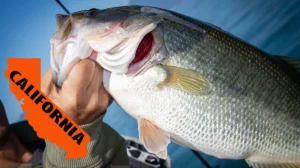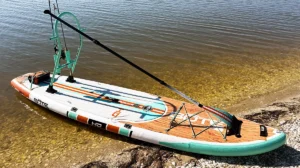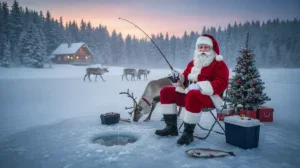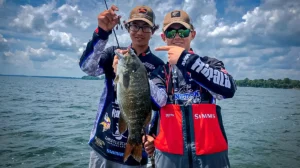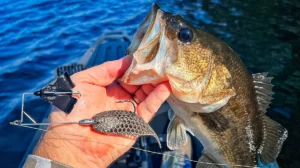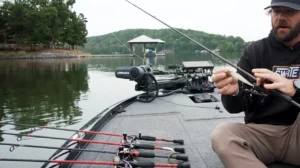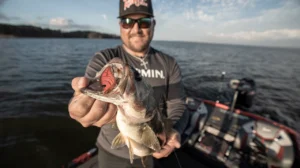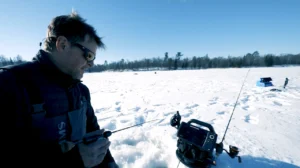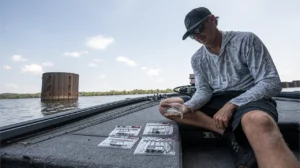When it comes to bass fishing, a spinnerbait is one of the most versatile lures in the tackle box. From burning a double willow leaf right along the surface to slow-rolling a big blade in 20 feet of water, there’s a way to target bass with a spinnerbait throughout a wide portion of the water column.
But picking the right spinnerbait for a given situation can be tricky, since there are hundreds of combinations of weights, colors, blade sizes, and blade types. Add in the optional trailers and trailer hooks, and it’s easy to get lost in the weeds. Today, we’re here to help simplify things a bit — hopefully a good bit. Here’s how to pick the perfect spinnerbait for any situation.
Blade Options
For starters, let’s look at the three main types of spinnerbait blades. The two most prevalent blades are willow leaf and Colorado. The willow leaf is longer and narrower, like an elongated diamond — or the leaf of a willow tree, if you’ve ever seen one. The Colorado blade is more circular, like a wide teardrop. Then there’s a hybrid of the two in the Indiana blade. This blade type isn’t as widely used, but it does have some die-hard fans.
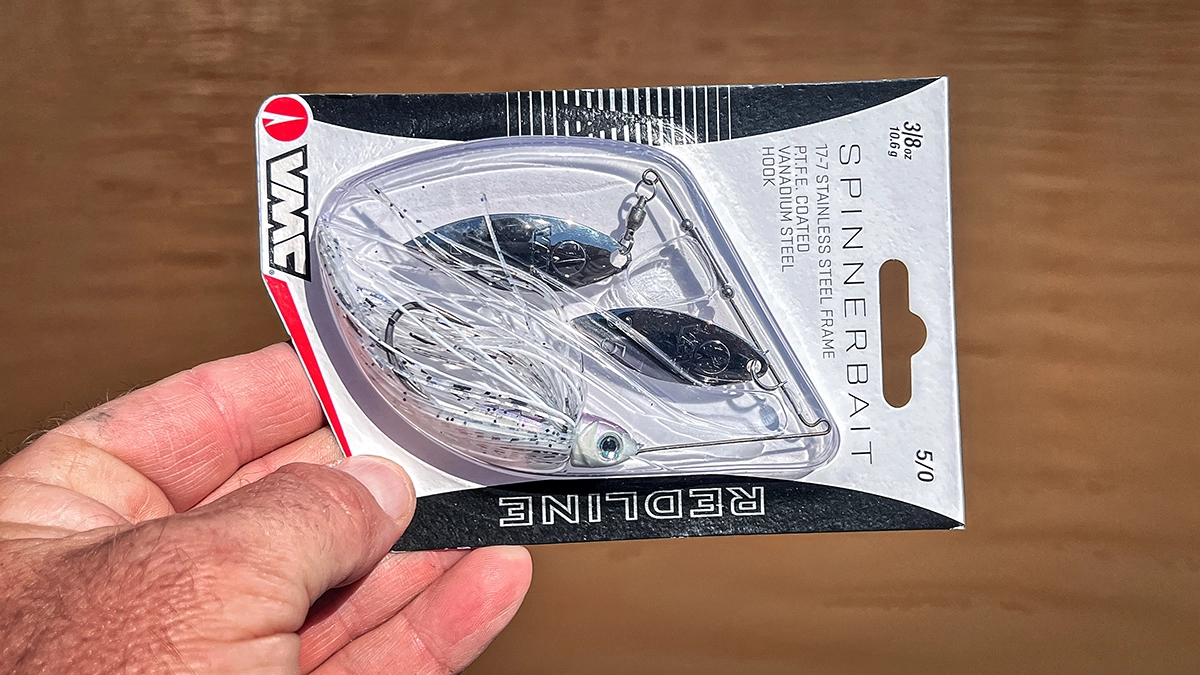
To put it simply, the willow leaf offers less resistance, the Colorado offers more resistance, and the Indiana blade falls somewhere in the middle. This is when comparing blades of similar size; a large willow leaf blade will create a harder thump than a small Colorado blade. But given a situation where all three (Colorado, willow, Indiana) are size 4, for example, the above statement holds true.
When it comes to blade color, most are nickel (silver) or gold. Bronze is also popular, as is black for night fishing. Some painted blades are particularly effective on smallmouth bass in clear water and largemouth bass in muddy water. However, nickel and gold are the most common and versatile, and they pair well together on baits with multiple blades.
Going a layer deeper, you get into blade combinations. The most popular two-blade combinations you’ll see are double willow leaf, double Colorado, and tandem Colorado/willow. There are also spinnerbaits that incorporate Indiana blades, those with a big single Colorado or willow leaf blade, and even others with three, four, or five small willow blades along the arm.
It’s worth noting that Booyah has an interactive tool to help you select the right blade combination for your spinnerbaits based on water color and temperature. It’s pretty accurate too. Check it their interactive Heat Map here, it will help take some of the guess work out.
Weight

When it comes to the weight of your spinnerbait, several factors must be considered. The most obvious is the depth you want to fish. The deeper you want to fish, the heavier your bait will need to be. That’s pretty straightforward, but it’s only step one. When you start experimenting with different blade combinations, you’ll find that a 1/2-ounce bait can reach 10 feet with two small willow leaf blades, while a single larger Colorado blade will only allow the 1/2-ounce bait to reach 2 or 3 feet at the same retrieve speed.
As a general rule, go with a 3/4-ounce spinnerbait when using any combination of fairly small blades (#4 and smaller). A half-ounce bait works well with midrange blade combinations (#3, #4, and/or #5). For #6 blades, you typically want to use a 3/4-ounce bait or heavier. That said, if you want to fish any of these combinations faster, lighten the bait’s weight. If you want to fish them deeper, increase the weight.
Color, Trailer, Trailer Hook

Though blade selection and weight are the most critical parts of picking the right spinnerbait, color matters a lot, too. In most cases, you want your color selection to do two things: match the hatch and help the bass find the bait. Practically, this looks like using a white skirt in muddy water when shad are present.
In this scenario, the shad will be paled out from the muddy water, making the bait easier for the bass to see. In clear water on a sunny day, a more natural, translucent shad pattern is ideal. But if the water is clear and it’s cloudy, a skirt with some natural colors and a few strands of chartreuse works really well.
Oftentimes, you won’t need a trailer or trailer hook to get bit. However, trailers can be helpful in certain situations. For instance, if you want to slow your bait down or beef up its profile, a double-tail grub or craw-style trailer can be effective. The same goes for a trailer hook. Typically, the fish will get the main hook, but if you have fish swatting at the bait and missing it, adding a trailer hook can increase your hookup ratio.
Different Scenarios
Now, let’s look at specific scenarios and which spinnerbaits are best for each.
Cold Water (Below 55 Degrees)

For cold water, you want a bait that you can fish slowly. By design, Colorado blades require slower retrieval. The resistance created by these blades causes a spinnerbait to ride high in the water column, so you need to slow it down to keep it down. This makes a Colorado blade or double Colorado blade spinnerbait, like the Berkley Power Blade Compact DBL Colorado spinnerbait above, ideal for cold water.
If you go with the double Colorado, a #3 and #5 blade combo is a good starting point, beefing up to a #4 and #6 if the water is particularly muddy. You can also use a single #6 blade or a #6 willow leaf, as these larger willow leaf blades generate a lot of resistance.
Warm Water (Above 55 Degrees)

In warmer water, you’ll want a faster-moving bait. Tandem Colorado/willow leaf baits work well in the 55- to 75-degree range, which is the sweet spot for a spinnerbait. Once the water gets hotter, the spinnerbait bite tends to die off. A great way to still catch fish is by burning a spinnerbait just below the surface. This works especially well when bass are chasing bait, even over deep water. A double willow leaf, like the ones seen on the Nichols Lures Catalyst Double Willow spinnerbait above, excels in this scenario, as it has a lot of flash without a lot of resistance.
Muddy Water

When fishing in muddy water, think about the thump given off by the spinnerbait. The harder the thump, the easier it will be for bass to track the bait using their lateral lines. This is why Colorado blades work well in muddy water, as do large willow leaf blades. The same blade selections that work in cold water also work well in muddy water. Therefore, lean toward a big #6 willow leaf blade or a double Colorado blade with #3 and #5. I modified this Nichols Pulsator with big, hammered Colorado blades for even more attraction.
Clear Water

For clear water, the best option is usually a natural color skirt that matches the hatch with smaller double willow leaf blades. Some lures have three or four small willow leaf blades that work well when small shad are present, especially in the fall or around shad spawns. Typically, a double willow leaf spinnerbait, such as this Nichols Catalyst, with two gold or two silver blades (depending on the forage present) works best in clear water. However, smallmouth bass love bright painted blades, even in clear water.
Moderately Stained Water
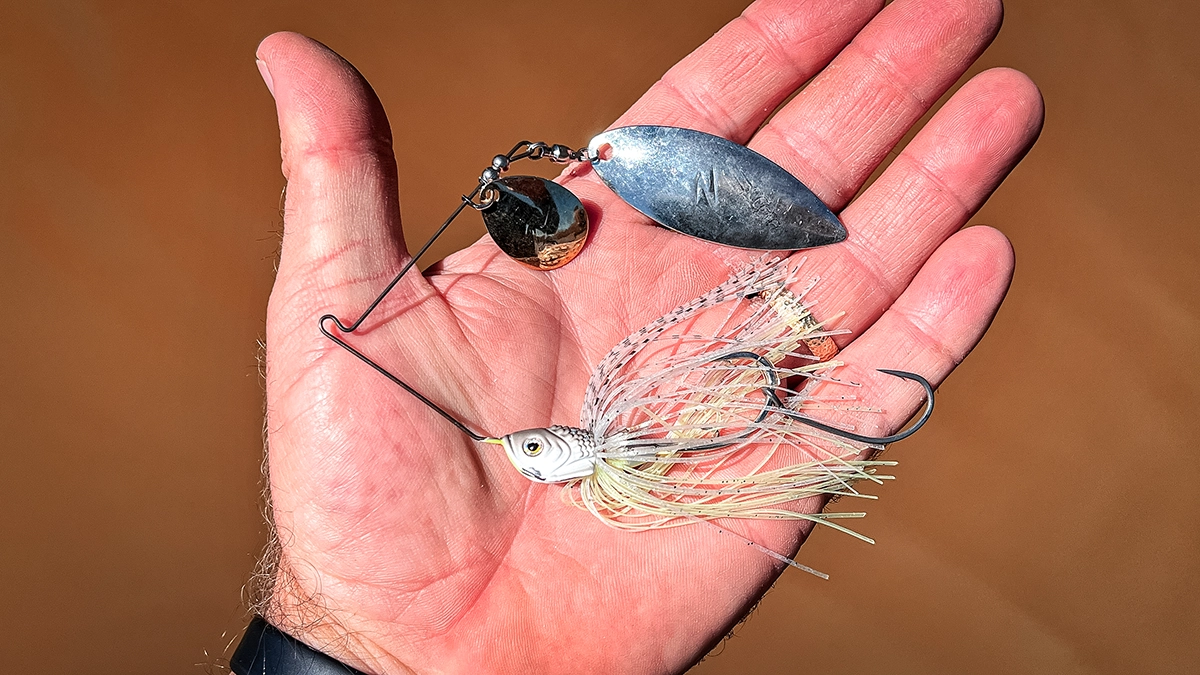
For stained water that’s neither muddy nor clear, a tandem Colorado/willow leaf spinnerbait, such as this Z-Man Sling BladeZ, with nickel and gold blades is ideal. This is a textbook spinnerbait setup that works perfectly in moderately stained water. These baits show up well in stained water and can be fished at a nice, moderate pace — not too fast, not too slow. Choose a skirt color that matches the hatch, with some solid strands and some translucent ones.
Nighttime

For night fishing, go with all black: black skirt, black blades, black trailer — as seen in the Booyah Moon Talker above. You can incorporate a few strands of brighter colors into the skirt. Bass are better able to track darker colors at night, for whatever reason. For the blades, either double Colorado blades or a big single Colorado blade works best. You want something that generates a lot of vibration and slows the bait down, both of which help the bass find it.
Deep Water

When fishing deeper than 10 feet, use a 3/4-ounce bait or heavier, typically with a single large blade (#6 or bigger). Large individual blades, like on the Booyah Covert Single Colorado seen here, give off a lot of vibration and flash, making them great for drawing strikes in muddy water, at night, or in deeper clear water during the day. These lures also fall faster and stay down better than those with two blades, like tandem-bladed baits, which are better suited for shallower water.
Final Thoughts
This isn’t an exhaustive guide on spinnerbait selection, as there are many ways to fish one. However, I believe you can apply this information to most spinnerbait situations and find a bait that will work well 90% of the time.
The basics are simple: The colder and/or murkier the water, lean toward Colorado blades and easily visible colors. The clearer and/or warmer the water, go with willow leaf blades and more natural or translucent colors. In stained water between 55 and 75 degrees, a tandem Colorado/willow leaf spinnerbait with a matching skirt color works best.
With just that info, almost anyone could take a spinnerbait to a nearby body of water and catch a fish. You can certainly get more technical with quad-blade baits, night blades, Indiana blades, painted blades, and more, but don’t overthink it. Use this guide to find a solid starting point, catch some fish, and refine your spinnerbait game from there. If you’re new to fishing, check out this basic guide on how to rig and fish a spinnerbait, and our complete rundown of the best spinnerbaits for all types of fishing.






